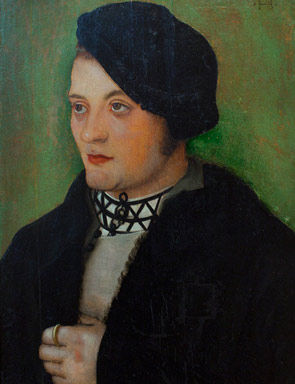Rutger's Zimmerli Art Museum Returns Rare Hans Baldung Grien's Portrait to Rightful Owners
Hans Baldung Grien, “Portrait of a Young Man”, 1509. Photo: Roy Groething
NEW BRUNSWICK, NJ.- On Friday, January 14, 2011, the Zimmerli Art Museum at Rutgers University handed over a rare early 16th-century portrait by the German artist Hans Baldung Grien to Simon Goodman, the Los Angeles-based grandson of Friedrich and Louise Gutmann, Holocaust victims and previous owners of the painting. In a visit to the Zimmerli, Mr. Goodman accepted “Portrait of a Young Man” (1509) on behalf of the Gutmann/Goodman heirs.
Since 1946, the Gutmann/Goodman family has been looking for this particular painting by Baldung Grien (c. 1484–1545), long considered the most gifted of the followers of Albrecht Dürer. Although many of the family’s artworks have been successfully recovered, this painting eluded both the family and the governments of France, the Netherlands, and West Germany. (For lack of evidence, the French and West German governments closed the case on the painting without resolution in 1960.)
It was only last year that Mr. Goodman finally found his family’s lost Baldung Grien upon encountering a rare copy of the 1983 catalogue raisonné of the artist by the noted German art historian Gert von der Osten.
“The restitution of World War II-era artwork is one of the most important legal and moral issues facing museums today, and we at Rutgers and the Zimmerli took the Goodman family’s claim most seriously,“ says Suzanne Delehanty, Director. “We have devoted almost a year to researching the case.”
“Portrait of a Young Man” was to have been featured in the newly conceived installation of the museum’s European collection, scheduled to open to the public in April. However, the Zimmerli voluntarily returned the painting to its rightful owners, consistent with the Report of the Association of Art Museum Directors' Task Force on the Spoliation of Art during the Nazi/World War II Era (1933 - 1945). Philip Furmanski, Executive Vice President for Academic Affairs at Rutgers, notes that, “From the beginning of this process, we have been committed to doing the right thing.”
“After so many years of dealing with art museums around the world, it has been a pleasure to work with Rutgers and the Zimmerli. Their professionalism and courtesy have been exemplary,” says Mr. Goodman.
HISTORY
Until spring 1941, Baldung Grien’s portrait of a young man resided in Bosbeek, the elaborately appointed 18th-century estate outside of Haarlem in the Netherlands belonging to the banker Friedrich (Fritz) Gutmann and his wife Louise. The 18 1/8 by 13 inch painting was part of an art collection that consisted of some 60 old masters, including works by Bosch, Botticelli, Cranach, Holbein and Memling, as well as Impressionist works by Degas and Renoir. The Baldung hung on red velvet amid other portraits of men in the “Gentleman’s Room” of Bosbeek.
The Gutmann collection, well known in Europe, caught the eye of Karl Haberstock, a German art dealer representing Adolf Hitler. Haberstock presented Fritz Gutmann’s agent in Paris with an order to turn over seven paintings, including the Baldung Grien, to him. The agent apparently obliged, but when the shipment arrived in Berlin, the Baldung Grien was missing. (After the war, Gutmann’s agent issued a statement to the authorities reaffirming the delivery of all seven paintings.)
The ensuing status of the painting is recounted somewhat cryptically in von der Osten’s catalogue raisonné, which merely states that the painting was in the hands of a `London dealer’ between 1948 and 1950, despite ongoing investigations by the French and West German governments and the Gutmann heir’s search for restitution. By 1953, the Baldung Grien appears to have been in the possession of the dealers Rosenberg and Stiebel of New York, who sold or transferred it to Rudolf Heinemann.
Mr. Heinemann gave the painting to Rutgers University in 1959.
THE FAMILY
As part of negotiations for the seven paintings, the Nazis had promised Fritz and Louise Gutmann safe passage to Italy. But in 1943, two SS officers arrived at Bosbeek to take the two to the train station and, hence, to the Theresienstadt concentration camp. Fritz Gutmann died there; Louise Gutmann was transferred to Auschwitz, where she died.
Immediately after the War, their children Bernard (Simon Goodman’s father) and Lili began their restitution and compensation claims.
Over time, the Gutmann/Goodman family has been instrumental in changing international policies on the restitution of looted art. A high-profile case involving the settlement of a Degas pastel from the Gutmann collection prompted a 1998 conference of 44 nations to adopt principles for resolving issues of Nazi-confiscated art. The basis for the Washington Principles was a set of guidelines established earlier that year by the Association of Art Museum Directors at a meeting hosted by the Worcester Art Museum in Massachusetts. Three months later, in 1999, the Commission for Looted Art in Europe was founded, opening the doors for the Goodmans and many other families to reclaim art and objects that had been looted by the Nazis.
Today, the 91-year-old Lili Gutmann resides in Florence, Italy. According to Simon Goodman, she is overjoyed to learn of this restitution, as is his brother Nicholas, who lives in London and Los Angeles.

/https%3A%2F%2Fprofilepics.canalblog.com%2Fprofilepics%2F1%2F0%2F100183.jpg)



/http%3A%2F%2Fstorage.canalblog.com%2F57%2F05%2F119589%2F61077165_p.jpg)
/http%3A%2F%2Fp9.storage.canalblog.com%2F92%2F51%2F119589%2F98216442.jpg)
/https%3A%2F%2Fassets.over-blog.com%2Ft%2Fcedistic%2Fcamera.png)
/https%3A%2F%2Fstorage.canalblog.com%2F77%2F60%2F577050%2F66527770_o.jpg)